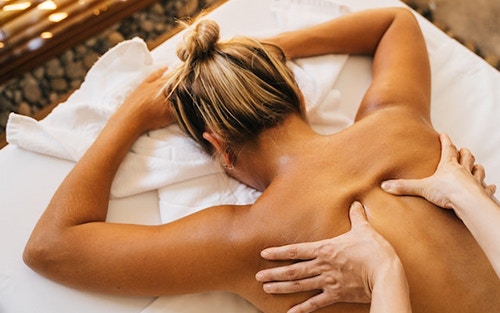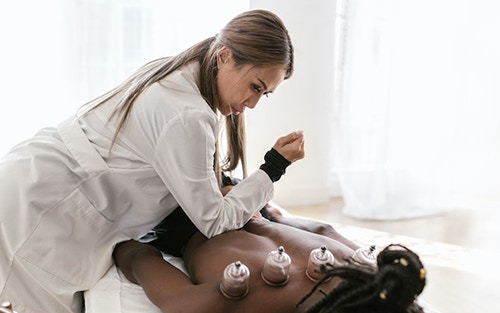In today’s fast-paced world, the importance of self-care cannot be overstated. Massage therapy has long been recognized as a powerful tool for promoting relaxation, reducing stress, and alleviating pain. Let’s explore the rich history, diverse techniques, and potential benefits of massage therapy. Whether you’re seeking relief from chronic pain or simply looking to unwind, a world of massage techniques is waiting to be discovered.
Short Summary
- Explore the many benefits of massage therapy, from its ancient origins to modern techniques
- Learn the various types of massages and how they can improve physical & mental health
- Uncover the steps necessary to become a licensed and properly trained massage therapist
- Discover massage techniques self-care options such as chair massage & trigger point therapy

Exploring Massage Therapy
The art of massage therapy has been practiced for thousands of years, with evidence of its use found in ancient civilizations such as China, India, Egypt, and Greece. Today, massage therapy has evolved into a highly diverse field, with over 80 styles available to suit various needs. From the relaxing strokes of Swedish massage to the targeted pressure of deep tissue massage, there is a technique for everyone.
From its humble beginnings as a healing practice in ancient cultures, massage therapy has become a respected profession. Over time, the development of massage techniques has been influenced by various cultures and medical advancements, leading to a wide array of options for individuals seeking relief from pain, tension, and stress.
As we explore the different types of massages and their benefits, let’s first take a closer look at the origins and evolution of massage therapy.
Massage therapy origins
Massage therapy can trace its roots back to ancient cultures, where it was used to promote health and wellbeing. Early civilizations in China, India, Egypt, and Greece practiced some form of massage therapy. For example, in China, various forms of massage were developed, including Pu Tong An Mo (general massage), Tui Na An Mo (pushing and grasping massage), and Dian Xue An Mo (cavity pressing massage).
The Iliad and Odyssey of Ancient Greece often mentioned massage with oils and aromatic substances. It was used to relax tired limbs and treat wounds. As time passed, massage techniques continued to evolve and spread to different parts of the world. Jivaka Komarabhacca, an Indian physician, is credited with developing a style that influenced modern Thai massage. In Hawaii, the traditional massage of Lomilomi was practiced by native Hawaiians.
These ancient practices laid the foundation for the diverse massage techniques we see today.
Evolution of massage techniques
The evolution of massage techniques has been influenced by various factors, including cultural exchange and medical advancements. Swedish massage, for example, was developed by Pehr Henrik Ling, a Swedish physical therapist, in the 19th century and introduced to the United States by two New York physicians, George and Charles Taylor. This popular technique uses five fundamental strokes: effleurage, petrissage, friction, tapotement, and vibration.
Over the years, new massage tools and techniques have emerged to meet the needs of clients and practitioners alike. Today, massage therapists have access to many tools, such as hand-held battery-operated massaging devices, vibrating massage pads, and dry-water massage tables. As the field of massage therapy continues to grow and evolve, so too do the techniques and tools available to practitioners, offering clients an ever-expanding range of options for health and relaxation.
Types of Massages and Their Benefits
A wealth of massage techniques are available to suit every individual’s needs and preferences. From the gentle, flowing strokes of Swedish massage to the deep pressure and stretching of Thai massage, each technique offers unique benefits for health and wellbeing. Some methods, such as sports massage, focus on addressing specific issues like injury recovery or athletic performance. In contrast, others, like hot stone massage, aim to promote deep relaxation and improve circulation.

Regardless of the technique chosen, massage therapy has been shown to provide numerous benefits, including pain relief, reduced anxiety and depression, improved sleep, and enhanced immune function.
There are other massage techniques, but as we explore various types of massages and their benefits, remember that the best massage service for you will depend on your individual needs and preferences. By understanding the different techniques available, you can decide which type of massage is right for you.
Swedish massage
Swedish massage is one of the most popular and widely recognized types of massage therapy. Known for its long, flowing strokes, this gentle massage technique promotes relaxation and reduces muscle tension. Swedish massage involves a combination of five distinct Swedish massage techniques. These are effleurage (sliding or gliding), petrissage (kneading), tapotement (rhythmic tapping), friction (cross fiber or with the fibers), and vibration/shaking. These strokes are designed to improve circulation, increase flexibility, and promote overall wellbeing.
In addition to its relaxing qualities, Swedish massage has been shown to provide various health benefits. Studies suggest regular Swedish massage sessions can help reduce stress, improve sleep, and strengthen the immune system. Whether you’re seeking a gentle, full-body massage to unwind or a more targeted treatment to alleviate muscle tension, Swedish massage is a versatile and accessible option for individuals of all ages and fitness levels.
Deep tissue massage
Deep tissue massage is another popular massage therapy technique that targets the deeper layers of muscle and connective tissue to relieve chronic pain and tension. This type of massage uses slow, deep strokes to reach the underlying muscles and fascia, focusing on areas of long-term discomfort or tightness. Kneading, tapping, and stretching techniques may also be incorporated to promote relaxation and flexibility.
The benefits of deep tissue massage include reduced chronic pain, improved range of motion, and relief from muscle tension. It’s important to note that some individuals may experience soreness or minor bruising following a concentrated tissue massage, but these side effects typically subside quickly.
As with any massage technique, it’s essential to communicate with your massage therapist about your specific needs and any existing medical conditions before receiving a deep tissue massage.
Sports massage
Sports massage is a specialized form of massage therapy designed to meet the unique needs of athletes and those engaging in physical activity. This type of massage focuses on preventing and treating injuries, enhancing athletic performance, and promoting recovery. Sports massage combines techniques from various massage styles, such as Swedish, deep tissue, and Thai massage, to address the specific needs of the individual.
The benefits of sports massage include improved joint range of motion, enhanced flexibility, reduced muscle tension, and neurological benefits. Additionally, sports massage can help reduce the risk of injury and speed up recovery after an event or workout.
Whether you’re a professional athlete dealing with a sports injury, or a weekend warrior, incorporating sports massage into your routine can help you stay at the top of your game.
Hot stone massage
Hot stone massage is a therapeutic massage technique that utilizes heated stones to relax muscles and improve circulation. During a hot stone massage, the massage therapist places heated stones on specific acupressure points on the body, using the stones to massage the muscles and facilitate deep relaxation. The stones’ warmth can help reduce pain and tension, allowing the therapist to work more effectively on the underlying muscles.

In addition to its calming effects, hot stone massage has been shown to reduce stress and anxiety, improve sleep, and boost circulation. This type of massage can be particularly beneficial for individuals experiencing chronic pain or muscle tension, as the heated stones can help to relax tight muscles and promote healing.
If you’re interested in trying hot stone massage, seek a qualified massage therapist experienced in this technique.
Shiatsu massage
Shiatsu massage is a form of Japanese massage therapy that applies pressure to specific points on the body to balance energy flow. This technique is rooted in traditional Chinese medicine and aims to unblock the body’s energy pathways, or meridians, by applying pressure to acupuncture points. Shiatsu massage practitioners use their fingers, palms, and sometimes elbows to apply pressure, helping to relieve pain and tension while promoting relaxation and overall wellbeing.
As an alternative medicine practice, Shiatsu massage has been used to treat various conditions, including stress, anxiety, and chronic pain. Though the evidence supporting its efficacy for specific medical conditions may be limited, many individuals find Shiatsu massage a relaxing and beneficial addition to their self-care routine.
If you’re interested in trying Shiatsu massage, seek a qualified practitioner experienced in this technique.
Thai massage
Thai massage is a form of traditional Thai medicine that combines stretching, deep pressure, and acupressure to increase flexibility and relieve tension. Stretching movements are an essential part of this technique. They help in improving body flexibility, enhancing joint movement, and increasing blood circulation across the body. Thai massage is typically performed on a mat on the floor, with the client wearing loose-fitting clothing to allow for easy movement during the session.
The benefits of Thai massage include increased flexibility, reduced muscle tension, and improved blood flow. Additionally, there are multiple reasons for it. Thai massage has been shown to be effective in managing conditions such as musculoskeletal pain and fatigue.
If you’re looking for a massage technique that combines deep pressure and stretching to promote relaxation and relieve tension, Thai massage may be an excellent option.
Complementary and Alternative Medicine
Massage therapy is part of integrative medicine and often considered a form of complementary and alternative medicine (CAM). CAM refers to a broad range of medical and healthcare systems, practices, and products not typically included in conventional medicine. In recent years, there has been a growing interest in incorporating massage therapy with other complementary therapies, such as acupuncture, reflexology, and chiropractic care, to provide a more holistic approach to health and wellness.

Integrating massage with other therapies can offer a comprehensive approach to health and wellbeing, addressing physical and emotional needs. By considering the whole person and addressing various aspects of their health, CAM practitioners can provide a more personalized and effective approach to care.
As we explore the use of complementary and alternative medicine in conjunction with massage therapy, let’s delve deeper into how essential oils and aromatherapy can enhance the massage experience and provide additional therapeutic benefits.
Essential oils and aromatherapy
Essential oils are natural plant extracts used in aromatherapy to promote physical and emotional wellbeing. An aromatherapy massage is a type of massage that incorporates the use of essential oils to enhance the massage experience and provide additional therapeutic benefits. By choosing specific essential oils based on their properties, aromatherapy massage can help alleviate stress, anxiety, and pain, and even improve sleep and boost energy levels.
During an aromatherapy oil massage, essential oils are often mixed with a carrier oil, such as almond or jojoba oil, and applied directly to the skin during the massage. They can also be used in diffusers or added to bathwater to create a soothing and relaxing atmosphere.
Incorporating essential oils and aromatherapy into your massage routine can enhance the overall experience and enjoy additional benefits for your physical and emotional wellbeing.
Integrating massage with other therapies
Incorporating massage therapy with other treatments, such as acupuncture, chiropractic care, and reflexology, can provide a comprehensive approach to health and wellbeing. By combining different modalities, practitioners can address various issues, from chronic pain and muscle tension to stress and anxiety. Integrating massage with other therapies also allows for a more personalized treatment plan tailored to each individual’s specific needs and goals.
The advantages of incorporating massage with other treatments include heightened relaxation, improved circulation, reduced stress, and enhanced overall wellbeing. It’s essential to consult with your healthcare provider and a qualified massage therapist before beginning any new treatment to discuss potential risks and ensure the best possible outcome for your health and wellness journey.
Professional Massage Therapists
Becoming a professional massage therapist involves completing a massage therapy program, passing an exam, and obtaining a license or certification. The specific requirements for licensure and certification vary by jurisdiction but typically include a combination of education and examination. In addition to formal qualifications, massage therapists must adhere to ethical standards and continue their education to stay up-to-date on the latest techniques and research in the field.

Professional associations, such as the American Massage Therapy Association (AMTA), play a crucial role in supporting and advocating for massage therapists. These organizations provide resources, networking opportunities, and continuing education for their members, as well as promoting the profession and increasing public understanding of the health benefits of massage therapy.
As we explore the world of professional massage therapists, let’s take a closer look at the process of becoming a massage therapist, industry associations, and regulations.
Becoming a massage therapist
The journey to becoming a licensed or certified massage therapist begins with completing a massage therapy program, which typically ranges from 500 to 1000 hours of theoretical and practical training. These programs cover various topics, including anatomy, physiology, massage techniques, and professional ethics. Once the program is completed, prospective massage therapists must pass an examination and obtain a license or certification, depending on the requirements of their jurisdiction.
In addition to formal education and licensure, massage therapists must commit to ongoing professional development and adhere to ethical standards. By staying current with the latest research and techniques, massage therapists can provide the best possible care for their clients and continue to grow as professionals in their field.
American Massage Therapy Association
The American Massage Therapy Association (AMTA) is the largest non-profit professional association for massage therapists, massage students, and massage schools in the United States. The AMTA offers its members a wide range of resources and benefits, including continuing education, professional development, networking opportunities, and access to liability insurance.
In addition to supporting its members, the AMTA plays a crucial role in advocating for the profession and promoting public understanding of the health benefits of massage therapy. The organization ensures proper training, licensing, and ethical standards for massage therapists, helping maintain the highest level of professionalism in the field.
Regulating massage therapy
The regulation of massage therapy varies globally, with some jurisdictions requiring licensure while others do not. In the United States, for example, most states require licensure for massage therapists, with specific requirements including completion of an accredited program, passing an examination, and ongoing education in massage techniques and ethics.
In other countries, such as South Africa and Germany, the requirements for licensure may differ, with varying levels of education and examination required.
Regardless of the specific regulatory framework, it is essential for massage therapists to adhere to the highest standards of professionalism and ethics, ensuring the best possible outcomes for their clients and the continued growth of the profession. In this context, efforts to regulate massage therapy are crucial in maintaining these standards.
Massage Techniques for Self-Care
Incorporating massage techniques into your self-care routine can provide numerous benefits, such as reduced stress, improved sleep, and increased overall wellbeing. Whether you’re seeking quick, targeted relief from muscle tension or a more comprehensive approach to relaxation, a variety of self-massage techniques can help you achieve your goals.

From chair massage and trigger point therapy to working with a remedial massage therapist, there are plenty of options for incorporating massage into your self-care routine. By exploring various techniques and finding the ones that work best for your individual needs, you can actively promote your health and wellness.
Chair massage
Chair massage is a convenient and accessible option for those seeking quick, targeted relief in public spaces or at home. This type of massage is performed while the client is seated on a specially designed massage chair, allowing the therapist to focus on the back, shoulders, neck, arms, and head. Chair massage is typically done over the client’s clothing and does not require oils or creams, making it an ideal option for busy individuals on the go.
The advantages of chair massage include reduced stress, tension, and anxiety, improved circulation, decreased muscle tension, and better posture. Whether you’re looking for a quick pick-me-up during your lunch break or a relaxing treatment at home, chair massage is a versatile option that can help you feel your best, no matter where you are.
Trigger point therapy
Trigger point therapy is a soft-tissue treatment that focuses on relieving pain and tension by applying pressure to specific points on the body. These points, or “trigger points,” can cause localized pain or refer pain and other sensations to different areas of the body. By applying pressure to these points, trigger point therapy can help alleviate discomfort and promote relaxation.
The benefits of trigger point therapy include decreased pain, increased range of motion, and optimized muscle performance. Whether you’re dealing with chronic pain, muscle tension, or simply looking to relax, incorporating trigger point therapy into your self-care routine can provide targeted relief and promote overall wellbeing.
Remedial massage therapist
Working with a remedial massage therapist can provide targeted, effective treatment for those dealing with specific issues, such as injury recovery or chronic pain management. These specialized massage therapists are trained in various techniques, including deep tissue massage, myofascial release, trigger point therapy, and physical therapy, to address each client’s unique needs.
The benefits of working with a remedial massage therapist include reduced pain, enhanced mobility, reduced inflammation, and improved circulation. By focusing on specific areas of the body that require rehabilitation, remedial massage therapists can help clients achieve lasting relief and improved overall wellbeing.
Summary
In conclusion, massage therapy is a powerful tool for promoting relaxation, reducing stress, and alleviating pain. With a rich history and diverse range of techniques available, a type of massage suits every individual’s needs and preferences. Whether seeking relief from chronic pain, looking to enhance athletic performance, or simply wanting to relax, incorporating massage therapy into your self-care routine can provide numerous benefits for your physical and emotional wellbeing. So why not explore the world of massage therapy and discover the best techniques for you?

Frequently Asked Questions
What should you not do before a massage?
It’s important to make sure you’re well-prepared before receiving a massage. Avoid eating a heavy meal, drinking alcohol, and exercising before your massage to maximize the experience.
Additionally, remember to arrive early to complete any paperwork or give yourself time to relax before your massage.
Is massage good for arthritis?
Overall, massage is a great way to manage arthritis symptoms. Regular massage therapy can reduce the intensity of arthritis pain, improve joint function, and improve overall quality of life.
It may also help promote better sleep and reduce stress levels.
What is the importance of massage?
Massage can be an incredibly effective to reduce stress, alleviate pain and muscle tightness, and increase relaxation. Massage can provide both physical and mental relief by prompting the release of endorphins and reducing stress hormone levels, promoting a sense of well-being and relaxation.
How much do you tip for massage?
Generally, the suggested amount to tip for a massage is 15%–20%. If you’re looking for a rough estimate of what to give your massage therapist, then tipping 15%-20% of the total massage cost is an excellent place to start. However, if you feel that your massage therapist deserves more than the standard tip, you can always give them extra.
Conclusion: The customary amount to tip a massage therapist is 15-20% of the service’s total cost. However, tips greater than this are always appreciated, and it is ultimately up to the customer to determine how much they wish to tip based on their experience.
What are the main types of massage therapy techniques?
Massage therapy techniques can be broadly categorized into four main types: Swedish, deep tissue, sports, and Thai massage. Each of these offers unique benefits and can help with various physical ailments and stress relief.
(706) 521-5290